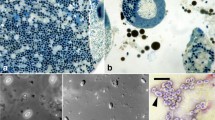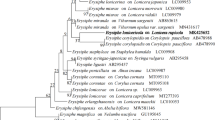Abstract
This study describes a new genus and species of microsporidia which is a pathogen of the elm leaf beetle, Xanthogaleruca luteola Muller, 1776 (Coleoptera: Chrysomelidae). The beetles were collected from Istanbul in Turkey. All developmental stages are uninucleate and in direct contact with the host cell cytoplasm. Giemsa-stained mature spores are oval in shape and measured 3.40 ± 0.37 μm in length and 1.63 ± 0.20 μm in width. These uninucleate spores have an isofilar polar filament with 11 turns. The spore wall was trilaminar (75 to 115 nm) with a rugose, electron-dense exospore (34 to 45 nm) and a thickened, electron-lucent endospore (65 to 80 nm) overlaying the plasmalemma. Morphological, ultrastructural, and molecular features indicate that the described microsporidium is dissimilar to all known microsporidian taxa and confirm that it has different taxonomic characters than other microsporidia infecting X. luteola and is named here as Rugispora istanbulensis n. gen., n. sp.




Similar content being viewed by others
References
Andreadis TG, Hanula JL (1987) Ultrastructural study and description of Ovavesicula popilliae N. G., N. Sp. (Microsporidia: Pleistophoridae) from the Japanese beetle, Popillia japonica (Coleoptera: Scarabaeidae). J Protozool 34:15–21. doi:10.1111/j.1550-7408.1987.tb03123.x
Balbiani EG (1882) Sur les microsporidies ou psorospermies des Articulés. C R Acad Sci Paris Ser D 95:1168–1171
Becnel JJ, Andreadis TG (2014) Microsporidia in Insects. In: Microsporidia: pathogens of opportunity. 1st ed. John Wiley & Sons, Inc., pp 521–570.
Becnel JJ, Jeyaprakash A, Hoy MA, Shapiro A (2002) Morphological and molecular characterization of a new microsporidian species from the predatory mite Metaseiulus occidentalis (Nesbitt) (Acari, Phytoseiidae). J Invertebr Pathol 79:163–172. doi:10.1016/S0022-2011(02)00032-0
Becnel JJ, Takvorian PM, Cali A (2014) Checklist of available generic names for microsporidia with type species and type hosts. In: Weiss LM, Becnel JJ (eds) Microsporidia: pathogens of opportunity. Wiley-Blackwell, USA, pp 671–687
Boucias DG, Pendland JC (1998) Phylum Microsporidia. In: Principles of insect pathology. Springer Science + Business Media, Llc, New York, pp 399–414
Brooks WM, Becnel JJ, Kennedy GG (1988) Establishment of Endoreticulatus n. g. for Pleistophora fidelis (Hostounsky and Weiser, 1975) (Microsporidia: Pleistophoridae) based on the ultrastructure of a microsporidium in the Colorado potato beetle, Leptinotarsa decemlineata (Say) (Coleoptera: Chrysomelidae). J Protozool 35:481–488
Felsenstein J (1985) Confidence limits on phylogenies: an approach using the bootstrap. Evolution 39:783–791
Hajek AE, Delalibera JI (2010) Fungal pathogens as classical biological control agents against arthropods. BioControl 55:147–158. doi:10.1007/s10526-009-9253-6
Hall TA (1999) BioEdit: a user-friendly biological sequence alignment editor and analysis program for Windows 95/98/NT. Nucleic Acids Symp Ser 41:95–98
Hylis M, Weiser J, Oborník M, Vávra J (2005) DNA isolation from museum and type collection slides of microsporidia. J Invertebr Pathol 88:257–260. doi:10.1016/j.jip.2005.02.004
Kimura M (1980) A simple method for estimating evolutionary rates of base substitutions through comparative studies of nucleotide sequences. J Mol Evol 16:111–120
Larsson JIR (2014) The primitive microsporidia. In: Microsporidia: pathogens of opportunity. First ed. (Eds: Weiss L.M. and Becnel J.J.). John Wiley & Sons, Inc., pp. 605–635
O’Mahony EM, Tay WT, Paxton RJ (2007) Multiple rRNA variants in a single spore of the microsporidian Nosema bombi. J Eukaryot Microbiol 54:103–109. doi:10.1111/j.1550-7408.2006.00232.x
Reynolds ES (1963) The use of lead citrate at high pH as an electron-opaque stain in electron microscopy. J Cell Biol 17:208–212. doi:10.1083/jcb.17.1.208
Solter LF, Becnel JJ, David HO (2012) Microsporidian Entomopathogens. In: Vega, F.E., Kaya, H.K. (Eds.), Insect Pathology. Elsevier Inc., pp. 221–263
Sprague V, Becnel JJ, Hazard EI (1992) Taxonomy of phylum Microspora. Crit Rev Microbiol 18:285–395
Spurr AR (1969) A low-viscosity epoxy resin embedding medium for electron microscopy. Clin Microbiol Res 3:197–218
Toguebaye BS, Bouix G (1989) Nosema galerucellae n. sp. Microsporidian (Protozoa, Microspora), parasite of Galerucella luteola Müller (Chrysomelidae, Coleoptera): development cycle and ultrastructure. Eur J Protistol 24:346–353. doi:10.1016/S0932-4739(89)80005-7
Undeen AH, Vávra J (1997) Research methods for entomopathogenic protozoa. In: Lacey L (ed) Manual of techniques in insect pathology. Biological techniques series. Academic Press, London, pp 117–151
Vossbrinck CR, Debrunner-Vossbrinck BA (2005) Molecular phylogeny of the microsporidia: ecological, ultrastructural and taxonomic considerations. Folia Parasitol 52:131–142. doi:10.14411/fp.2005.017
Vossbrinck CR, Maddox JV, Frideman S, Debrunner-Vossbrinck BA, Woese CR (1987) Ribosomal RNA sequence suggests microsporidia are extremely ancient eukaryotes. Nature 326:411–414. doi:10.1038/326411a0
Vossbrinck CR, Baker MD, Didier ES, Debrunner-Vossbrinck BA, Shadduck JA (1993) Ribosomal DNA sequences of Encephalitozoon hellem and Encephalitozoon cuniculi: species identification and phylogenetic construction. J Eukaryot Micorbiol 40:354–362. doi:10.1111/j.1550-7408.1993.tb04928.x
Wang Y, Liu W, Jiang Y, Huang L, Irfan M, Shi S, Yang R, Qin L (2015) Morphological and molecular characterization of Nosema pernyi a microsporidian parasite in Antheraea pernyi. Parasitol Res 114:3327–3336. doi:10.1007/s00436-015-4558-0
Weiser J, Wegensteiner R, Zizka Z (1995) Canningia spinidentis gen. et sp. n. (Protista: Microspora), a new pathogen of the fir bark beetle Pityokteines spinidens. Folia Parasitol 42:1–10
Wu Z, Jamieson S, Kielbaso J (1991) Urban forest pest management. J Arbor 17:150–158
Yaman M, Bekircan Ç, Radek R, Linde A (2014) Nosema pieriae sp. n. (Microsporida, Nosematidae): a new microsporidian pathogen of the Cabbage Butterfly Pieris brassicae L. (Lepidoptera: Pieridae). Acta Protozool 53:223–232. doi:10.4467/16890027AP.14.019.1600
Acknowledgments
The TEM analysis of this study was carried out in Eskişehir Osmangazi University (ESOGU) Central Research Laboratory, Research and Application Centre (ARUM). We are thankful to Assoc. Prof. İlknur Dağ and her team for making this study possible and her valuable comments.
Author information
Authors and Affiliations
Corresponding author
Rights and permissions
About this article
Cite this article
Bekircan, Ç., Bülbül, U., Güler, H.İ. et al. Description and phylogeny of a new microsporidium from the elm leaf beetle, Xanthogaleruca luteola Muller, 1766 (Coleoptera: Chrysomelidae). Parasitol Res 116, 773–780 (2017). https://doi.org/10.1007/s00436-016-5349-y
Received:
Accepted:
Published:
Issue Date:
DOI: https://doi.org/10.1007/s00436-016-5349-y




